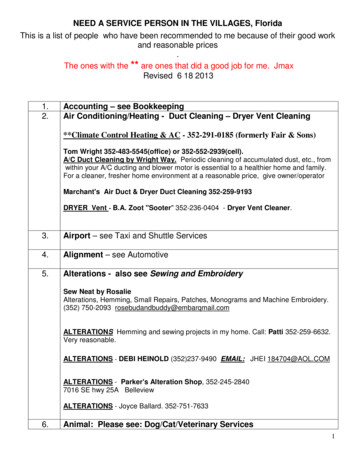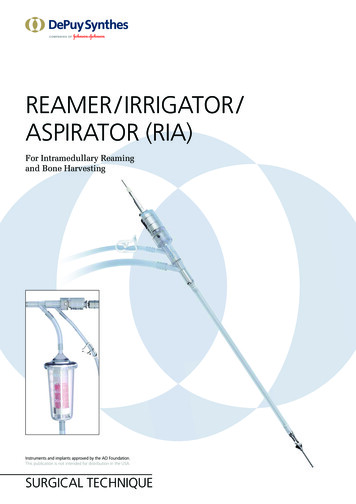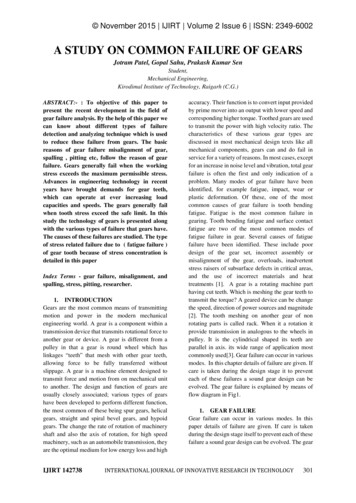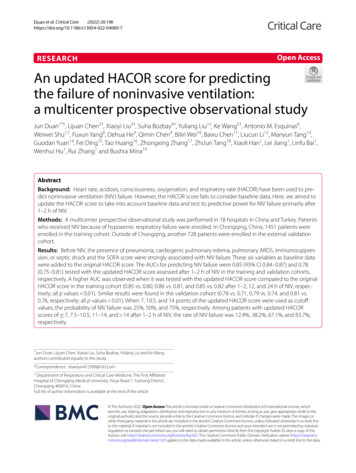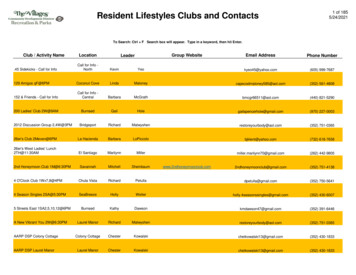Transcription
Peters et alFailure properties of silicone-gel breast implantsFailure properties of 352 explantedsilicone-gel breast implantsWalter Peters PhD MD FRCSC, Dennis Smith PhD DSc FRCS, Stanley LugowskiMScDivision of Plastic Surgery and the Centre for Biomaterials, Wellesley Hospital and theUniversity of Toronto, Toronto, OntarioW Peters, D Smith, S Lugowski. Failure properties of 352 explanted silicone-gelbreast implants. Can J Plast Surg 1996;4(1):55-58. There have been three generationsof silicone-gel breast implants. First generation implants (thick wall – thick gel withDacron patches) were made from 1963 to 1972. Second generation implants (thin wallthin gel) were made from 1972 until the mid 1980s. The introduction of third generationimplants (stronger wall, low-bleed) was geographically dependent. In Canada, DowCorning Silastic II implants were introduced in 1986, and Surgitek SCL implants wereintroduced in 1988. In the present study, a total of 352 silicone-gel breast implants wereremoved from 239 patients between 1981 and 1995. Their failure properties weredependent upon their generation (year of manufacture) and, for second generationimplants, their duration in situ. Of the 352 implants, 20 were first generation, and allwere fully intact. Twenty-eight were third generation implants, and 27 were fully intact.Failure properties of the 302 second generation implants were dependent upon theirduration of implantation. A survival curve indicated that these implants began to fail (byleaking or rupturing) after four years in situ. By six years, 40% had failed. After 12years, 95% had failed. Of the 171 second generation implants removed between 1991and 1995, 77% had failed. The failure properties were similar for the three mainmanufacturers: Dow Corning, Heyer-Schulte and Surgitek. The failure rate for secondgeneration implants is much higher than was previously believed. This is particularlysignificant in view of the current difficulty in diagnosing implant failure.Key Words: Breast implant, Rupture, Silicone-gelCaractéristiques de 352 implants mammaires au gel de silicone retirés pourdéfectuositéRÉSUMÉ: Nous avons connu trois générations de prothèses mammaires au gel desilicone. La première génération de prothèses (paroi épaisse, gel épais avec pièceDacron) a été fabriquée de 1963 à 1972. Les prothèses de deuxième génération (paroimince, gel mince) ont été fabriquées de 1972 jusqu’au milieu des années 1980. LaCAN J PLAST SURG VOL 4 NO 1 SPRING 1996
Peters et alFailure properties of silicone-gel breast implantsproducton de la troisième généneration de prothèses (paroi plus résistante, hémorragieminime) a varié selon certains facteurs géographiques. Au Canada, les prothèses DowCorning Silastic II ont fait leur entreé en 1986 et les prothèses Surgitek SCL, en 1988.Dans le cadre de la présente etude, 352 prothèses mammaires au gel de silicone ont étéretirées de 239 patientes entre 1981 et 1995. Les propriétés liées à leur échecdépendaient de la génération dont elles faisaient partie et, dans le cas d’implants dedeuxième génération, de la durée de leur presence in situ. Sur les 352 prothèses, 20étaient de première génération et toutes étaient intactes. Vingt-huit étaient de troisièmegénération et 27 étaient entièrement intactes. Les propriétés des 302 prothèses dedeuxième génération défectueuses dépendaient de la durée de leur implantation. Selonune courbe de survie, ces prothèses on commencé à être défectueuses (à fuir ou à seromper) après quatre ans in situ. Au bout de six ans, 40 % étaient défectueuses; aprèshuit ans, 95 % étaient défectueuses. De ces 171 prothèses de deuxième génération,retirées entre 1991 et 1995, 77 % étaient défectueuses. Les défectuosités étaientsemblables pour les trois grands fabricants : Dow Corning, Heyer-Schulte et Surgitek. Letaux d’échec des prothèses de deuxième génération est beaucoup plus éléve qu’on l’avaitd’abord cru. Cela revêt une importance significative, compte tenu de la difficulté actuelleà diagnostiquer les défectuosités des prothèses.An understanding of the evolution of silicone-gel breast implants is important inorder to analyze their failure properties. These implants were initially introduced in 1963by Dow Corning as a new natural feel prosthesis'. From 1963 until 1972, Dow Corninghad a nearly exclusive monopoly on their manufacture. These first generation' implantswere composed of a thick (firm) gel and a thick elastomeric wall. They had wovenDacron patches on their posterior surface to anchor them to the chest wall in an attempt toprevent ptosis. These implants have proven to be much stronger than those developedsubsequently (1). Surgeons soon learned that many women who received these implantsdeveloped very firm (and often painful) breasts. This was due to capsular contracture, aprocess that was not well understood. Manufacturers surmised that this firmness was dueto the firmness of the implants. They therefore decided to make implants that felt softer,with the naive notion that these softer (second generation) implants would result in softerbreasts.In 1970, Don McGhan -- who had been the chief engineer at Dow Corning from1963 to 1970 -- joined Heyer-Schulte and subsequently developed the first soft( Cohesive') gel implant. Heyer-Schulte released this implant in 1972, featuring "asilicone-gel with a high degree of softness previously unknown to the medicalprofession".Medical Engineering Corporation (which subsequently became Surgitek),introduced a similar product in the United States in 1972, but it was not released inCanada until 1979. Dow Corning introduced a comparable product (the Responsive Gel')in the United States in 1975, and in Canada in 1978. All second generation implants had a softer gel' and a thinner wall than first generation implants.Some manufacturers continued to offer fixation patches as options on secondgeneration implants, but they were usually composed of (solid) silicone rather thanCAN J PLAST SURG VOL 4 NO 1 SPRING 1996
Peters et alFailure properties of silicone-gel breast implantsDacron, or Dacron embedded in silicone sheeting. These patches resulted in less fixationthan the original Dacron patches. As more of these softer' implants were inserted, theirfailure properties began to become evident. Occasionally, implants would break duringinsertion. Others were found to be ruptured at open capsulotomy. Manufacturersresponded to these findings in their product inserts, stating that "currently availablemammary protheses are not perfect -- the elastomer has a low tear strength and is thin toachieve softness". Manufacturers initially endorsed the autoclaving of silicone-gelimplants. Subsequently, when the walls of these implants were noted to tear easily(particularly if they were still hot), companies added a disclaimer against autoclaving.Surgeons soon noticed that many patients who had received second generationimplants also developed firm breasts, in spite of the soft' nature of the implants. In 1975,the concept of closed capsulotomy was introduced, whereby a firm breast could bevigorously squeeezed by the surgeon, to break down' the scar tissue around the implantand thereby reduce the firmness (2). Initially, manufacturers endorsed this method oftreatment in their product inserts. However, by 1976 it was noted that some patients whohad undergone this manipulation had developed implant rupture. Implant companies thenchanged their product inserts, to provide a disclaimer against closed capsulotomy, and tostate that if an implant is ruptured, it should be replaced. In 1978, the pressures generatedduring closed capsulotomy were shown to be in the order of 15 pounds per square inch(2). This strengthened the concept that implants could rupture during closed capsulotomy.Throughout the 1970s, saline inflatable implants were also marketed by manyimplant manufacturers. However, the high rate of spontaneous deflation of these implantswas notorious. Most surgeons therefore usually preferred to use silicone-gel implants.The American Society of Plastic and Reconstructive Surgery has estimated that from1963 to 1992, over 95% of all breast implants inserted were made of silicone-gel (3)rather than saline.As the failure properties of the soft second generation' implants became moreapparent, further studies demonstrated measureable levels of silicone in the capsulessurronding implants (3). It was thought that this free silicone' could contribute tocapsular contracture. Since 1978, it has been recognized that a small amount of siliconecan be expected to bleed' from all clinically intact gel implants (3). This phenomenonhas been shown to increase under load, and to involve primarily low molecular weightcomponents (6,000 to 10,000) (4). More recently, these silicone bleed levels have beenshown to be much higher than was anticipated. In fact, the capsule silicon levels (derivedfrom silicone by extraction of capsular tissue with organic solvents) with intact siliconegel implants have recently been shown to be comparable to the capsule silicon levels withruptured implants (5).Manufacturers addressed the problems of rupture and bleed by developing the third generation' implant, which had a stronger shell (High Peformance [HP] elastomer),and an inner surface which was coated with a barrier layer' to reduce the diffusion ofsilicone. In 1974, the American Hospital Supply Company acquired Heyer-Schulte andDon McGhan and his team formed a new company -- McGhan Medical. The companyreleased the first third generation' implant -- the Intrashiel -- in 1979. It had a diphenylbarrier layer of proprietary composition, between an inner and outer layer of HPelastomer. Other companies followed with similar types of implants, The new' DowCorning (Silastic II) implant had a fluorosilicone layer to restrict silicone bleed (aboutCAN J PLAST SURG VOL 4 NO 1 SPRING 1996
Peters et alFailure properties of silicone-gel breast implants50% of the methyl groups on the polysiloxane chains were replaced with trifluoropropylgroups). The corresponding Surgitek implant (Strong Cohesive Low-Bleed [SCL]) alsohad a diphenyl barrier layer. Other companies introduced other types of barrier layers.The introduction of third generation implants was geographically dependent. The SilasticII implant was introduced by Dow Corning in the United States in 1981 and in Canada in1984. The Surgitek SCL implant was introduced in the United States in 1986 and inCanada in 1988. Any study of implant failure must therefore take into account thegeographic location of the study.In addition to the bleed' phenomenon, silicone-gel implants can fail by leaking orrupturing. Leaking implants have visibly sticky silicone-gel on their surface, and in theimplant pocket. The silicone will string out' over a variable length (6). These implantsusually demonstrate a small hole (often only a pinhole) when pressure is applied to them(5). Ruptured implants demonstrate frank tears in the implant shell.MATERIALS AND METHODSThe present retrospective study was designed to analyze the failure properties of352 silicone-gel breast implants, which were explanted (by WP) from 1981 to 1995. Overhalf of the implants had originally been inserted by other surgeons. Patients from twotime intervals were evaluated: 1981 through 1991; and 1992 through 1995.These two populations were different. In the first group (1981 through 1991), 169silicone-gel implants were removed from 125 patients. Most of these patients (96%)sought treatment because of capsular contracture. All of these patients except one hadtheir implants replaced.In the second group (1992 through 1995), 217 implants were removed from 115patients. This group was affected by the increased negative publicity about silicone-gelbreast implants. Many were concerned about the ultimate safety of their implants. Overhalf of these patients elected to forego the insertion of further implants. The remainderhad saline implants inserted.RESULTSImplant integrity: Of the 169 second generation implants which were removed from1981 through 1991, the median implantation time was only two years. The failure ratewas 13.7%. This group provided data for the early failure rates of second generationimplants (one to four years). Of the 217 implants removed from 1992 through 1995, themedian implantation time was five years. The integrity of these implants was dependentupon the generation of the gel implant and, for second generation implants, the durationof implantation. Of the 217 implants, 18 were from the first generation (1961 to 1972)(Table 1). These were all fully intact. Twenty-seven of 28 of the implants from the thirdgeneration were also fully intact. Of the 171 implants from the second generation, only23% were intact -- 77% had leaked or ruptured.CAN J PLAST SURG VOL 4 NO 1 SPRING 1996
Peters et alFailure properties of silicone-gel breast implantsTABLE 1: Implant status versus implant generation for 217 silicone-gel breastimplants removed between 1991 and 1995. Failed implants had leaked or ruptured.Generation N Failed (%)1. 1963-1972 18 0 (0)2. 1973-1987 171 132 (77)3. 1988-1992 28 1 (4)Failure properties of second generation implants: The failure properties of 312 secondgeneration implants were evaluated as a function of their duration in situ. The failure ofthese second generation implants was dependent upon the duration of implantation(Figure 1). Second generation implants began to fail (by leaking or rupturing) after aboutfour years. Failure then increased with time in situ. When leaking and ruptured implantswere combined (Figure 2), about 40% of the implants had failed by six years. After 12years, about 95% of these implants had failed. There were no significant differencesbetween the rupture rates of the three main manufacturers: Dow Corning, Heyer-Schulteand Surgitek.Figure 1) Implant integrity of 302 second generation silicone gel implantsremoved from 1981 to 1995CAN J PLAST SURG VOL 4 NO 1 SPRING 1996
Peters et alFailure properties of silicone-gel breast implantsFigure 2) Implant integrity of 302 second generation silicone-gel implantsremoved from 1981 to 1995 (leaks and ruptures from Figure 1 are combined)DISCUSSIONMechanical failure of silicone-gel breast implants has proven to be more commonthan was previously appreciated. Through 1992, the rate of implant disruption wasthought to be low -- in the range of 4 to 6% (7,8). In 1993, de Camara and co-workersanalyzed 51 implants inserted from about 1973 onwards (9). Fifty-three percent wereruptured and 14% were leaking. All implants older than 10 years were leaking orruptured. In 1994, Peters and colleagues (1) analyzed 102 implants and demonstrated asimilar relationship between duration of implantation and implant failure. Only 7% of 45implants which had been in place for five years or less showed failure. Of 29 implants inplace for six to 10 years, 69% had failed. In 1995, Robinson and colleagues showed asimilar failure rate of 63.5% in a large group of implants (6). The majority of theseimplants were second generation.The present study indicates that 77% of patients with second generation siliconegel breast implants currently have leaking or ruptured implants. This failure begins afterfour years, involves 40% of implants after six years, and involves about 95% of implantsafter 12 years in situ. It should be pointed out that all of the patients in this studyrequested surgery because they were having problems related to their breast implants. Inthe first group of patients (1981 through 1991), 95% demonstrated significant (Baker IIIIV) capsular contracture. In the second group, about 75% also had significant capsularcontracture. A further 15% complained of other symptoms. It is possible, therefore, thatCAN J PLAST SURG VOL 4 NO 1 SPRING 1996
Peters et alFailure properties of silicone-gel breast implantsthe failure rate in the patients in this study may be higher than that of other populations of control' patients, who were not having problems related to their implants (11).The etiology of implant failure remains to be fully elucidated. Implants maysimply undergo a progressive deterioration with time. In addition, closed capsulotomyhas been documented as a potential cause of implant failure (12,13). Clinical studies,however, have not shown a direct correlation between disruption and closed capsulotomy(6,13).Of major concern today is the difficulty in diagnosing leaking or rupturedsilicone-gel breast implants. Although mammography is helpful to diagnose extracapsularrupture (6,14), only 5% of the patients in this study demonstrated extracapsular rupture.The vast majority of implant failures are intracapsular. The sensitivity rate ofmammography to detect intracapsular rupture is only 11 to 16% (6,16). For patients withintracapsular rupture, magnetic resonance imaging (MRI) is helpful to predict rupture.However, its sensitivity rate is very operator dependent, and for most centres is probablyin the range of about 50% (15,17). Ultrasound techniques and clinical evaluation are lessaccurate than MRI to predict rupture (5,16-18).Based on the present study and other recent publications (1,6,9), about 80% of allsecond generation silicone-gel implants are currently ruptured or leaking. Others areexpected to rupture with further time. Should all second generation implants ultimatelybe explanted? The Food and Drug Administration has recommended that broken implantsbe removed. The gel was originally intended to be contained within the elastomeric shell.If the shell has failed, intuitive reasoning would suggest that these implants should beremoved. However, implant removal has a significant morbidity, particularly regardingsubsequent breast deformity. In addition, these patients originally sought surgery becauseof their breast size and shape. They may be particularly concerned about a secondarydeformity. Furthermore, if these patients choose to have their gel implants replaced withsaline implants, there may be significant cosmetic concerns about the visible rippling'associated with saline implants, particularly if they are inserted pre-pectorally.Because of these reasons, most surgeons are currently hesitant to remove gelimplants routinely from this large number of patients when there is not proof that they areruptured. In addition, there have been no proven health concerns in patients, even withimplant rupture. If patients have a significant degree of capsular contracture (Baker IIIIV), or other significant concerns, the decision to proceed with explantation may beeasier, both for the patient and the surgeon.If an implant has failed, should the capsule be removed during explantation? Thecapsular tissue contains a large foreign-body load of silicone (5). Capsulectomy seemsreasonable in order to reduce this load, even though few deleterious effects have beendemonstrated from leaving the capsule in place. Because the capsules of intact implantshave been shown to contain silicon levels comparable to those of ruptured implants, onecould also argue that consideration be given to the removal of all capsules atexplantation. Currently, however, there is no uniform agreement about the role of routinecapsulectomy when silicone-gel implants are removed.ACKNOWLEDGEMENTS: This research was funded by a Medical Research Councilof Canada University Industry grant, and by funding from Dow Corning CorporationCAN J PLAST SURG VOL 4 NO 1 SPRING 1996
Peters et alFailure properties of silicone-gel breast implantsREFERENCES1. Peters WJ. Factors affecting the rupture of silicone-gel breast implants. Ann Plast Surg1994;32:449-51.2. Gruber RP, Friedman G. The pressures generated by closed capsulotomies ofaugmented breasts. Plast Reconstr Surg 1978;62:379-80.3. Barker DE, Retsky MI, Schultz S. Bleeding' of silicone from bag-gel breast implantsand its clinical relation to fibrous capsule reaction. Plast Reconstr Surg 1978;61:836-41.4. Callahan T. Tensile strength and liquid silicone bleed. In FDA General Plastic SurgeryDevices Panel Meeting, February 1992. Transcript Vol 1:73-84.5. Peters WJ, Smith DC, Lugowski S, et al. An analysis of silicon levels in capsules ofgel and saline breast implants and of penile prostheses. Ann Plast Surg 1995;34:578-84.6. Robinson OG, Bradley EL, Wilsori DS. Analysis of explanted silicone implants: Areport of 300 patients. Ann Plast Surg 1995;34:1-7.7. Angell M. Breast implants: Protection or paternalism? N Engl J Med 1992;326:1695-6.8. American Society of Plastic and Reconstructive Surgeons. Breast Implant Update,March 10, 1992.9. de Camara DL, Sheridan JM, Kammer BA. Rupture and aging of silicone gel breastimplants. Plast Reconstr Surg 1993;91:828-34.10. Fisher JC. Invited discussion. Ann Plast Surg 1995;34:6-7.11. Nelson GD. Complications from the treatment of fibrous capsular contracture of thebreast. Plast Reconstr Surg 1980;66:969-70.12. Eisenberg HV, Barrels JJ. Rupture of silicone bag gel breast implant by closedcompressive capsulotomy. Plast Reconstr Surg 1979;59:849.13. Peters WJ. The rupture of silicone-gel breast implants. Ann Plast Surg 1994;33:462-3.14. Anderson B, Hawtof D, Alani H, et al. The diagnosis of ruptured breast implants.Plast Reconstr Surg 1989;84:903-7.15. Ahn C, Shaw W, Narayaan K, et al. Definitive diagnosis of breast implant ruptureusing magnetic resonance imaging. Plast Reconstr Surg 1993;92:681-91.16. Bassen LVW, Brenner RJ. Consideration when imaging women with breast implants.AJR 1992;159:979-81.17. Peters WJ, Smith DC, Grosman H, Fornasier V. Role of mammography to assesscomplications of silicone gel breast implants. Can J Plast Surg 1995;3:l50-6.18. Peters WJ, Pugash R. Ultrasound analysis of 150 patients with silicone gel breastimplants. Ann Plast Surg 1993;31:7-9.CAN J PLAST SURG VOL 4 NO 1 SPRING 1996
implants (stronger wall, low-bleed) was geographically dependent. In Canada, Dow Corning Silastic II implants were introduced in 1986, and Surgitek SCL implants were introduced in 1988. In the present study, a total of 352 silicone-gel breast implants were removed from 239 patients between 1981 and 1995. Their failure properties were

